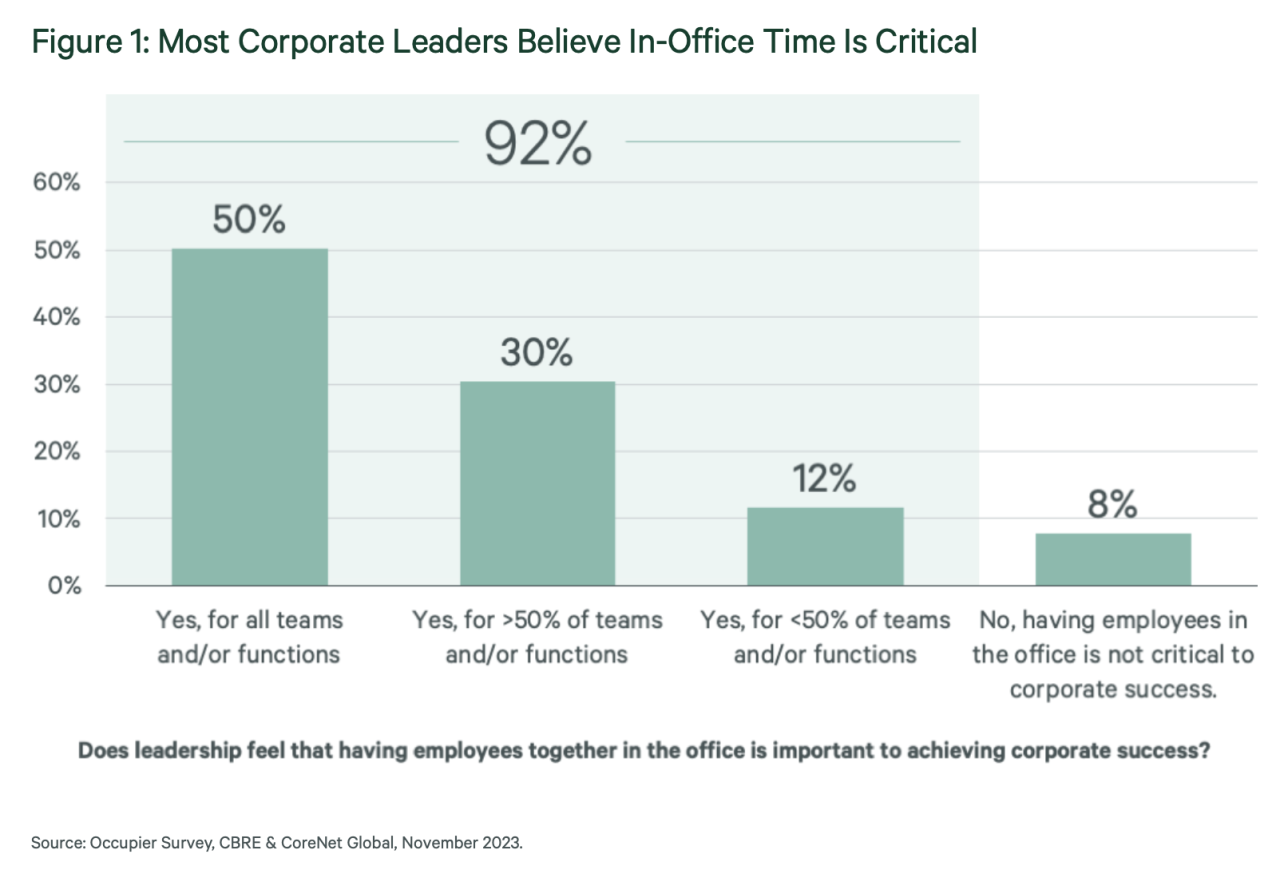Boosting Office Attendance: Selling & Delivering Workplace Value to Employees
- None.
- None.
NORTHAMPTON, MA / ACCESSWIRE / February 8, 2024 / CBRE Group, Inc.
Many companies and their employees remain out of sync on the amount of time workers should be in the office, according to a CBRE and CoreNet Global survey of 235 corporate real estate professionals. This finding makes it readily apparent that companies must do a better job of aligning the anticipated benefit of the office with the employee experience and building a culture and workplace that supports that value proposition. This report's recommendations build on previous findings from CBRE's Spring 2023 Office Occupier Sentiment Survey.
Office Attendance Is Mission-Critical for Corporate Success
Ninety-two percent of survey respondents indicated that the office is an important part of ensuring corporate success, with half holding this belief for all job functions.
Yet, corporate leadership expectations for office attendance remain out of sync with employee behavior. Survey respondents indicated that, on average, corporate leaders want employees in the office 3.4 days per week, while the actual rate is 2.8 days. Nearly
Respondents indicated that, on average, corporate leaders want employees in the office 3.4 days per week, while the actual rate is 2.8 days.
Forty-one percent of respondents expect that attendance will increase from current levels. However, over half of those respondents who expect an increase do not believe their employees are aligned with leadership beliefs about the purpose of the office. More action likely is needed to influence employee behavior.
Over half of those respondents who expect an increase do not believe their employees are aligned with leadership beliefs about the purpose of the office.
Reinforcing the Value Proposition of the Office
While most respondents said they were communicating their expectations of office attendance to their employees, this alone does not appear enough to motivate employees to work in the office more frequently. Companies now are increasingly focused on communicating the value proposition of working in the office to their employees.
Two-thirds of respondents said that they have clearly defined and communicated the value proposition of being in the office to their employees. Interpersonal connections are critical to the most important values cited and therefore are difficult to foster in a virtual work environment: collaboration, knowledge sharing and relationship building. Professional development-based values such as mentorship, onboarding and learning & development are also cited by more than half of respondents. Fewer respondents indicated that the office was necessary to achieve goals that can be accomplished remotely, including productivity and innovation.
Two-thirds of respondents said that they have clearly defined and communicated the value proposition of being in the office to their employees.
Employee attendance improves when company leadership effectively communicates the value proposition of the office. Fifty-seven percent of companies that clearly communicated the value of the office reported that employees were in the office more than three days per week, while only
Employee attendance improves when company leadership effectively communicates the value proposition of the office.
Beyond simply communicating the benefits of office attendance,
Occupiers Continue to Match Portfolios to Future of Work
Even though the office remains mission-critical and attendance is expected to increase,
One-third of respondents also said they are measuring workplace effectiveness in helping to drive corporate success, including metrics on employee engagement, employee retention and space utilization.
Many are strategically positioning their leased and owned assets to align with their value proposition of the office and in turn help drive corporate success.
The gap between companies' office attendance expectations and their employees' behavior likely will close in the near-term as corporate messaging, culture and the workplace are adjusted to match the value proposition of the office.

View additional multimedia and more ESG storytelling from CBRE Group, Inc. on 3blmedia.com.
Contact Info:
Spokesperson: CBRE Group, Inc.
Website: https://www.3blmedia.com/profiles/cbre-group-inc
Email: info@3blmedia.com
SOURCE: CBRE Group, Inc.
View the original press release on accesswire.com







